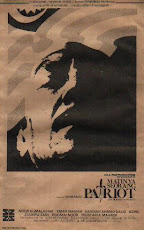#320. LayarTech : The Tech Behind Rorschach's Mask in Watchmen
 Creating Rorschach's signature look took months of R&D and plenty of experiments with ink and fabric. Here's how filmmakers created the striking look of Watchmen's beloved antihero.
Creating Rorschach's signature look took months of R&D and plenty of experiments with ink and fabric. Here's how filmmakers created the striking look of Watchmen's beloved antihero.
Dr. Manhattan might be the only true superhero among them, but Rorschach is the real face of Watchmen—or at least his ever-shifting mask is. So director Zack Snyder and visual-effects supervisor John "DJ" DesJardin made sure to nail the look of the last masked vigilante standing. Although Manhattan's artistic creation was by the book—DesJardin estimates he used the graphic novel as a reference at least "a million times"—Snyder had something different in mind for Rorschach. "In the graphic novel the explanation [for the mask] is that there are two plastic membranes with fluid between them, and the fluid moves like a lava lamp," DesJardin says. "We wanted to keep the essence of that movement, but Zack thought it would be interesting and more detailed for the film if we could keep it as a cloth medium, and the stain moved through the cloth."
Snyder also wanted to have shades of gray in his blots rather than the stark, hard-edged black spots found in the graphic novel. Getting the right look and saturation was a long process of experimentation with different types of fabric and ink. DesJardin and costume designer Michael Wilkinson finally settled on a stretchy, four-way latex material, which—in addition to having the fibrous look Snyder wanted—helped create Rorschach's smooth eggshell silhouette. They printed the blots on the material using a special process developed specifically for the latex.
Jackie Earle Haley, who played Rorschach, couldn't shoot the film while blinded by a mask, so Wilkinson created a mask with large eyeholes so that Haley could see the set and animators could see how he was emoting in each scene. Embedded in the mask were 30 tracking dots 2 centimeters in diameter, which animators used to determine the orientation of Haley's head in the shot. "That gave us the texture so we could put the blots on [in postproduction]," DesJardin says. In addition, several "hero blot masks" with static patterns were generated, which were used for medium- to-long distance shots. "We'd have Jackie or the stunt performer wear them if they were in the distance or in shadow," DesJardin explains. "Those were good references for how the blots should look on the mask when we finally made them."
When it came to creating the blots themselves, animators couldn't use real Rorschach blots because they're copyrighted. "That was a surprise!" DesJardin says. He commissioned Alex McDowell in the film's art department to come up with 15 fake Rorschach blots. The VFX supervisor and his team also created a reference book of Dave Gibbons's blot art from the graphic novel. When the dialogue in the script matched the dialogue in the graphic novel, DesJardin made sure Rorschach's mask matched the novel, too. "We were hitting those Dave Gibbons targets first and foremost," DesJardin says. "Hopefully, fans will go, 'Hey! I remember that from when he's walking down the tunnel on the subway!'"
Animators customized plug-ins in the 3D animation program Maya that allowed them to create the blots in 2D, then move the shapes around on a textured surface—in this case, the shape of Healy's face as denoted by the tracking markers embedded in the mask. Each animation was handled on a sequence-by-sequence basis. "We created an animation that was longer than the sequence was," DesJardin explains. "If the sequence was 300 frames, we would make 1600 frames of animation so that we had a way to squash and stretch how long certain shots were taking."
The blots would move faster or slower based on what Rorschach was experiencing—when he was excited, for example, the blots would move quickly; when the vigilante was thoughtful, the blots would percolate. "More often than not, Zack thought we had it about right," DesJardin says, "but he would call me out if he thought we were overanimating it." The only time the blots stop moving is when Rorschach takes the mask off or lifts it up. For those scenes, Haley wore one of the static hero masks.
The first shots of the blots came in May 2008 and the last shots were done in November 2008. "Not to say that every shot took eight months, but it's a good few weeks per sequence," DesJardin says.
Off all the Rorschach scenes, DesJardin is most happy about an emotional scene near the end of the film. "Jackie's performance is so subtle, and I think it looks really good," DesJardin says. "It's almost like you're seeing, through the mask, to the pain he's going through. I think that came out really well."
Source : PopularMechanic







0 ulasan:
Catat Ulasan